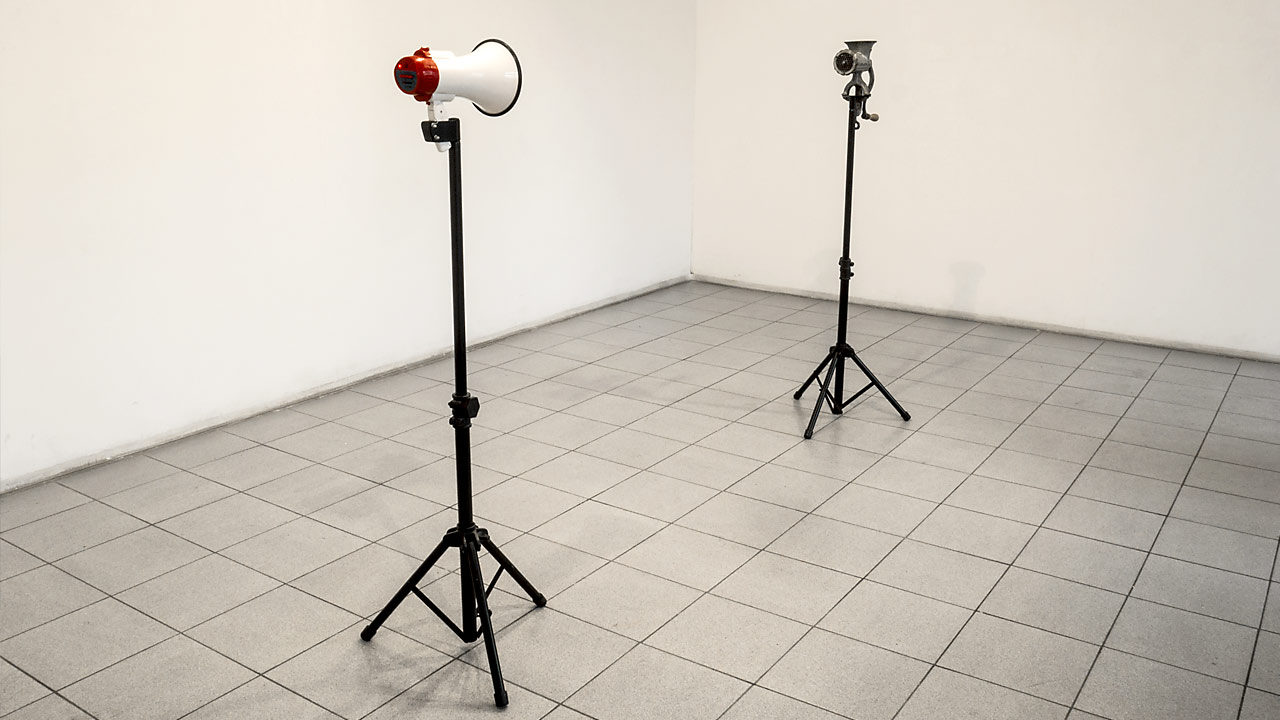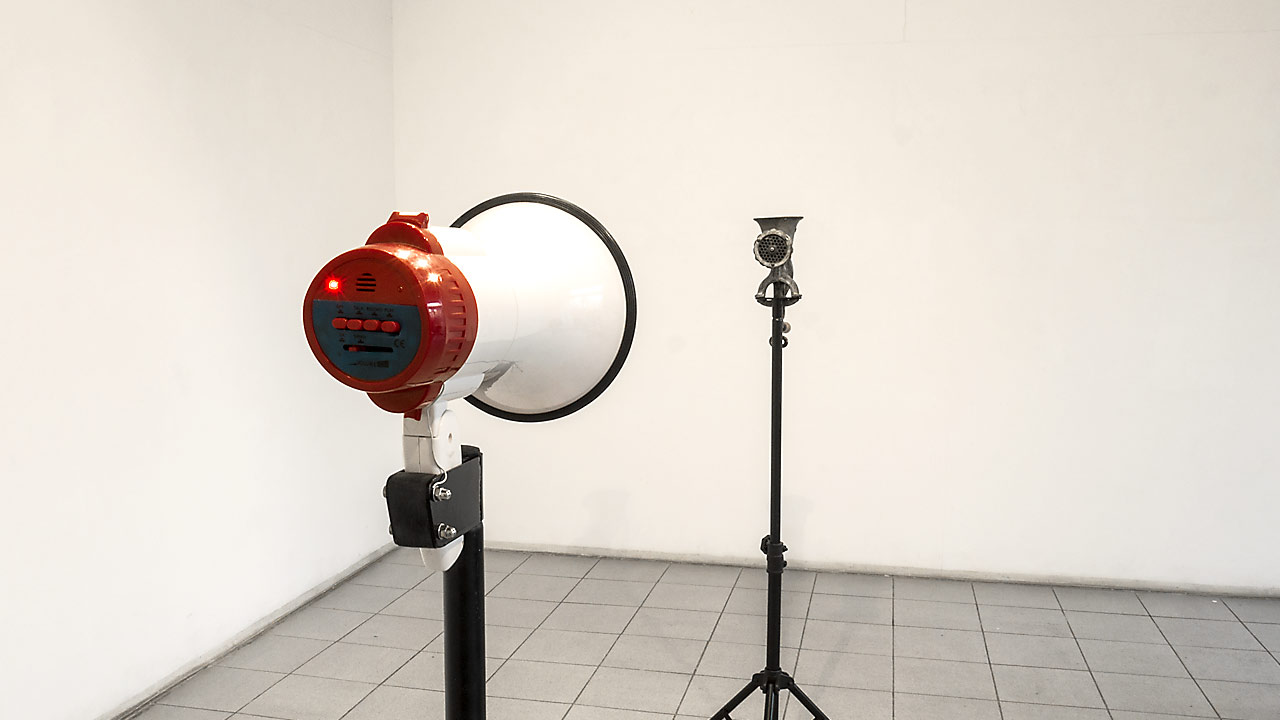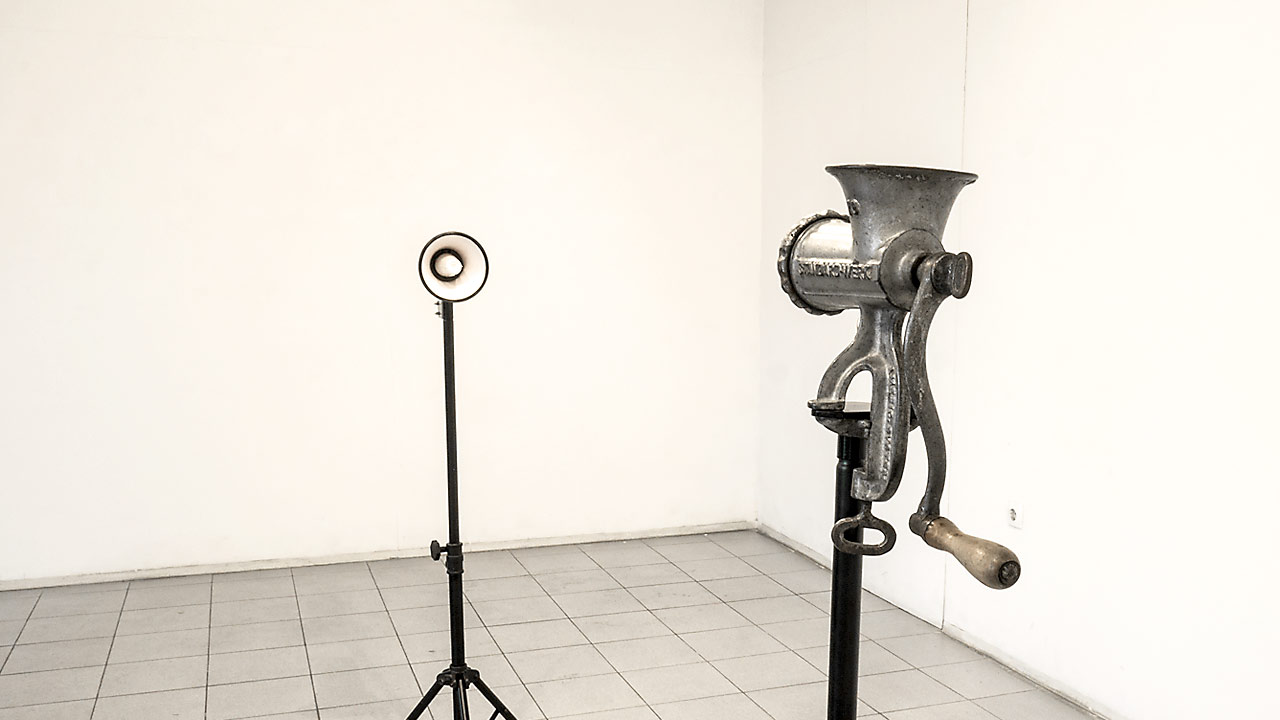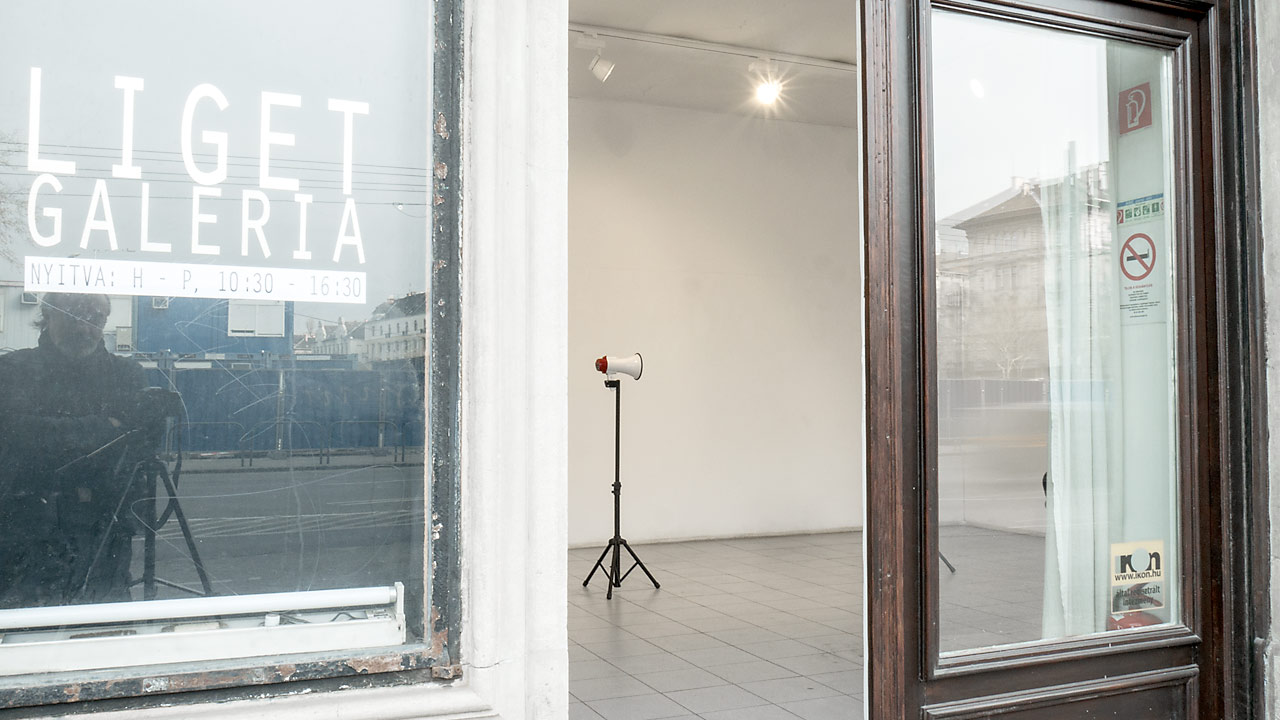Acoustic Shadow
Genre: sound installation
Date: 2018
Size: ~ 300 x 50 x 150 cm
Materials: megaphone, mincer, iron, electronics
Location: Liget Gallery, Budapest, Hungary
Photo: Joseph Tasnadi
ACOUSTIC SHADOW
„Ivan Ivanovich and Yusup Yusupovich are sitting in a country house. There is a samovar on the table; they are drinking tea. It is snowing outside. Ivan Ivanovich says:
– How beautiful Marfa Petrovna was! Oh, my god, how nice the evening was at the duke’s ball!
There comes a long pause, a typically Chekhovian one, then Yusup Yusupovich answers:
– Should I winter the cattle in Italy? It would cost one ruble per cow.
A Chekhovian pause.
Ivan Ivanovich replies:
– If only you had seen her clothes! Aw, the dress! And how she waltzed, she waltzed, she waltzed…
Chekhovian pause.
Yusup Yusupovich again:
– And if I leave them here? They will be weatherbeaten by the pummeling snow, and
eventually freeze.
Chekhovian pause.
Ivan Ivanovich’s turn:
– But Marfa Petrovna has never dignified me with a glance, no. She has not, not even once.
(…) Yusup Yusupovich:
– Apparently, it is snowing in big flakes on the porch.
Ellipsis.
– It is true that frozen beef is cheaper with some kopecks, but still, should I pay one whole ruble for each cow?
Ivan Ivanovich sais:
– And sweet Marfa Petrovna only danced with the duke, only danced with the duke, only danced with the duke…”
(Nichita Stănescu)
The Ideal Dialog
We have the capacity to monologize, but monologue is unsatisfying. And then we have a perpetual need for dialog, which is insatiable.
It is actually impossible to be perfectly involved in a dialog. Our participation at all times remains incomplete due to the fact that we ask, respond and declare at the same time. Of course, the participants are thinking radically different from each other. The ideal dialog can only occur in the monologue – whatever absurd it sounds – where the question and the answer or the declaration are the results of the same mind.
Still…
We keep attempting for a dialog because monologues are unsatisfying. In the dialog, the monologues start to converge while also keeping their parallel directions. It is like the parallels of the Bolyai-Lobachevskian hyperbolic geometry but instead of approaching
each other, they do not even meet at infinity.
The convergence is thus just the intention of the dialog – its real outcomes are characterized by parallelism. The controversy of the dialog is constituted by this duality.
The fact that it cannot be caught in the act is due to its linear nature. Consecutiveness is a defect of the verbal and textual expression. Live speech and written text are not provided with the dimension of simultaneity.
The instance in which dialog as a product can be observed is the visual representation, more precisely, it is the static view. The dialog must materialize in space or on a surface to make its convergent parallels intelligible. That is how dialog can be turned conceivable, avoiding the volatility of the spoken or written formats.
The chance for this resides in the simultaneity of a view. The building blocks of a dialog – the statements, the questions, and the answers – are simultaneously exposed as materialized parts of an irrevocable, unrepeatable and (quasi-)concluded process. The parallel courses encounter and freeze within one sight that has never existed before.
The parallel discourse lines generate an interface that makes every linear process synchronous. It erases temporality while it also visualizes it.
**********
AKUSZTIKUS ÁRNYÉK
„Ivan Ivanovics és Juszup Juszupovics az udvarházban ülnek; az asztalon szamovár, teát isznak. Odakint havazik. Megszólal Ivan Ivanovics.
– Milyen szép volt Marfa Petrovna! Istenem, milyen szép volt az este, a herceg bálján.
Hosszú, jellegzetesen csehovi csend következik, majd Juszup Juszupovics így válaszol:
– Vajon teleltessem-e a csordát Olaszországban? Fejenként egy rubelt kellene fizetnem.
Csehovi szünet.
Ivan Ivanovics válaszol:
– S látta volna, hogy volt felöltözve! Ó, az a ruha! És hogy keringőzött, hogy keringőzött, hogy keringőzött…
Csehovi szünet.
Újra Juszup Juszupovicsé a szó:
– Ha meg itt tartom őket? Csak veri őket a hó, s a végén még megfagynak.
Csehovi szünet.
Ivan Ivanovicson a sor:
– Marfa Petrovna azonban pillantására sem méltatott, nem bizony, még egyszer sem méltatott pillantására.
(…) Juszup Juszupovics következik:
– Látnivaló, hogy odakint a tornácon nagy pelyhekben hull a hó.
Három pont.
– A fagyott marhahús néhány kopejkával olcsóbb ugyan, de még akkor is, fizessek minden marháért egy rubelt?
Mire Ivan Ivanovics így szól:
– És Marfa Petrovna, a drága, csak a herceggel táncolt, csak a herceggel táncolt, csak
a herceggel táncolt…”
(Nichita Stănescu)
Az ideális párbeszéd
Van a monológ képessége, amely nem kielégítő. És van egy örökös párbeszédigény, amelyet képtelenség kielégíteni.
A párbeszédben voltaképpen lehetetlenség tökéletesen részt venni. A részvétel mindig részleges marad, mivel egyidejűleg vagyunk kérdésfeltevők, válaszadók és kijelentők. Persze a résztvevők gondolkodása – enyhén szólva sem egybeeső. Az ideális párbeszéd – abszurd módon – csak a monológban valósulhat meg, amikor kérdés és válasz és kijelentés – egyazon agy szüleménye.
Mégis…
A dialóguskísérletek azért jönnek létre, mert a monológok nem kielégítőek. A dialógusban a monológok konvergens irányt kapnak, ugyanakkor a párhuzamosság is megmarad. Olyan ez, mint a Bolyai-féle hiperbolikus geometria párhuzamosai, amelyek úgy közelednek egymáshoz, hogy még a végtelenben sem találkoznak.
A dialógus főleg szándékaiban épít tehát a konvergenciára, eredményében azonban a párhuzamosság a domináns. A párbeszéd ellentmondásossága ebben a kettősségben mutatkozik meg.
„Tettenérhetetlensége” időbeli linearitására vezethető vissza. A verbalitás és a textualitás „hiányossága” az egymásutániság.
Az élőbeszéd és az írott szöveg nem rendelkeznek az egyidejűség dimenziójával.
Ahol a dialógus – mint eredmény – mégis tetten érhető, az a vizualitás, azon belül a statikus látvány. A dialógusnak térben és/vagy felületen materializálódnia kell ahhoz, hogy a konvergens párhuzamosság megragadhatóvá váljon. A dialógus csak ebben a formában jeleníthető meg, kiküszöbölvén a szóban vagy írásban folytatott párbeszéd illékonyságát.
A lehetőség a látvány egyidejűségében van. A párbeszédet alkotó elemek, a kijelentések, a kérdések és a válaszok egyidejűleg – egy (kvázi) lezárt folyamat, immáron vissza nem vonható, megismételhetetlen, anyagiasult részeiként vannak jelen. A párhuzamos folyamatok egy addig nem létező látványban találkoznak és rögzülnek.
A párhuzamos diskurzusok egy olyan felületet generálnak, amely egyidejűvé teszi azt, ami addig lineáris folyamat volt.
Megszünteti az időbeliséget, ugyanakkor meg is jeleníti azt.



